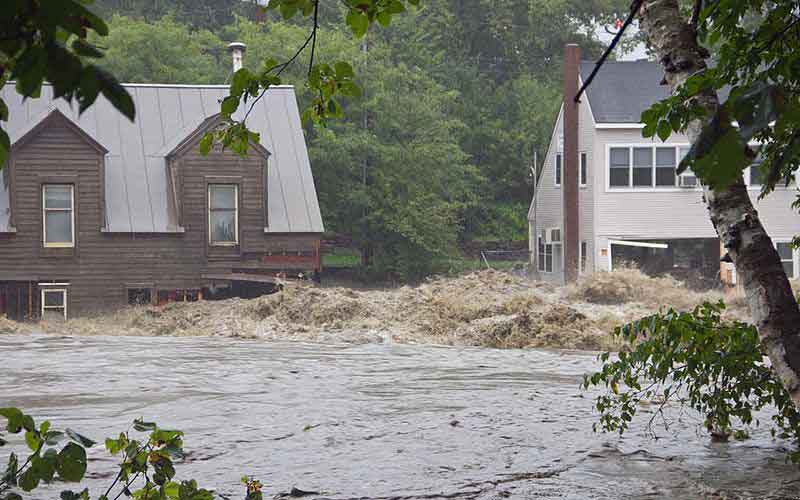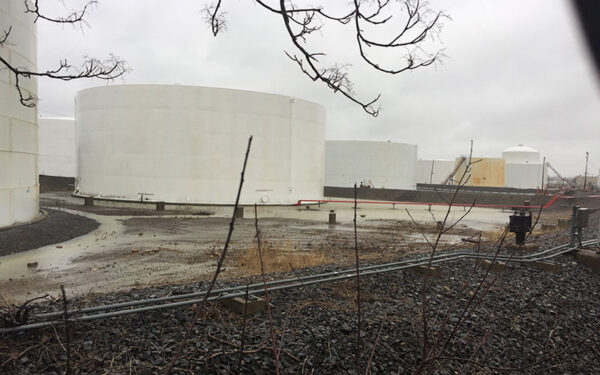
Tropical Storm Irene Floods Buildings in Quechee Vermont. And nearly 10 years later, we see such flooding more frequently in the state because of climate change. Photo: Environmental Protection Agency.
We value nature not just because it provides for us, or for its functionality, but also because of the connection it forges within us. Nature can evoke a sense of oneness – that we are all one family, one planet. The air around us is the same as the air within me.
Growing up in rural Kerala, India, my intrinsic connection to our natural world was all too familiar. We lived in an agrarian environment where everything grew in the land around us: rice, mangoes, coconut, jackfruit, guava, neem trees, cashew nuts, peppercorn, turmeric, and so much more. We ate what we grew, we made oil from coconuts and brooms from palm leaves. Sarppakavu, or Snake Shrines, were an untouched patch of nature found near most houses in the area. The oil lamps we lit every evening at our Sarppakavu forever etched in me a deeper spiritual bond with and reverence for nature and its creatures.
But Our Connection to Nature is Much More
In the 1990s, I started noticing something quite troubling. Birds, snakes, and frogs had been dying in the paddy fields close to my house for a few summers. I learned that these deaths were related to years of indiscriminate pesticide spraying that started with the “Green Revolution,” an attempt to reduce poverty by increasing agricultural production via new technologies.
People were falling ill as well. After visits to the farms for research, I myself fell sick and nauseous for a couple days. This experience made it obvious and personal that the health of our communities is inextricably connected to that of our environment.
I also witnessed disparities in who experienced the environmental threats from pesticide spraying. The farmworkers lived with greater risks of day-to-day exposures than other communities. I realized that the people most impacted by environmental risks are those left vulnerable from historical marginalization and neglect. We must address these injustices to solve the environmental and health crises we face in our world.
I’ve carried this passion with me to my current work, teaching environmental justice and environmental health at the University of Vermont. Even all the way across the world from Kerala, I still see connections between our environment, human health, and the dire need for justice for those ignored as we contend with the greatest threat yet: climate change.
Climate Change Threatens Our Environment and Our People
We know a great deal about climate change. There’s so much data about what’s happening, what could happen. Still, we’re dealing with a phenomenon that’s incredibly unpredictable, other than the certainty that it will cause damage.
Here in Vermont, climate impacts are many. Vermont’s annual precipitation has risen seven inches in the past 50 years. That had led to more frequent flooding as rising waters overtake our rivers and submerge our streets.
Flooding harms our buildings and homes, drowns our farms, and washes toxins into our streets. Pesticides, herbicides, manure, oil, and other pollutants from our farm fields and streets flow into rivers that drain into Lake Champlain and other water basins. The economic impact is significant, as well, with researchers projecting the damages caused by increased flooding will skyrocket by 148% in Vermont over the next 100 years without intervention.
What’s more, rising temperatures together with nutrient pollution could increase toxic algae outbreaks in our lakes and rivers, among other impacts. Such outbreaks kill native fauna and can make our pets and people very sick.
But we also must think more deeply about these consequences. Which counties get hit the hardest? Who is able to evacuate and relocate if needed? Which communities can afford repairs to avoid sanitation issues, or upgrades to improve chronic, weakened infrastructure?
That’s Where Environmental Justice Can Help Vermont
The simple fact is that our governments do not distribute the benefits of laws and policies equally to all communities. Environmental injustices are built on centuries of colonization, industrialization, and capitalism. Historically subjugated and ignored communities of color and those with low socioeconomic status have been trapped in a cycle of inequity that exposes them to higher risk and premature death. That is true across the world – and it is true in Vermont.
It’s not that these communities don’t care about environmental threats. Studies show that Hispanic, Latino, and Black people are the most alarmed about climate change. However, their voices are not heard or supported by the corporate culprits who pollute and the decision makers who respond.
We know what we need to do. The fossil fuel industry – coal, oil, and gas – cause climate change. We must transition to clean energy solutions now.
The good news is Vermont is taking bold moves to address climate change. The legislature in 2020 passed its climate law mandating an 80% cut to climate-damaging emissions by 2050. And the State Climate Council released a preliminary plan to reach those targets. Now, it’s up to us to make sure that we finalize the plan and guide its implementation in a just way, that we slow the destruction of climate change for all Vermonters.
Clean Energy and Energy Justice can Protect Our Health
Breaking our addiction to fossil fuels must happen in a way that supports those communities most vulnerable to climate change. Communities with low socioeconomic status, Vermonters of color, and those living in more rural counties all face the burdens of fossil fuel infrastructure in unique ways. From not being able to afford individual climate solutions to living in areas lacking investment in public or electric transportation infrastructure, a clean energy transition is that much harder for these communities.
That’s why our climate solutions must be intersectional. That is, they need to consider not just the environment, but also income issues, housing disparities, food insecurities, and so much more. For example, wealthier Vermonters can afford to invest in home solar panels and heat pumps. Those changes will benefit them through cleaner indoor air quality and safer energy infrastructure. But Vermonters with low incomes (or who don’t own property) are less likely to be able to make those same investments. That also means they won’t enjoy the health and safety benefits those investments can bring.
In my work on energy justice – we focus specifically on how we can transition to clean energy systems in a way that benefits the local community, increases community control of energy solutions, and local decision-making around energy issues. As we work ourselves free from the shackles of Big Gas and Oil, our move towards a clean energy future must be centered from the ground up – listening to frontline voices and amplifying their efforts to abate the crisis.
Otherwise, we risk re-creating the same system as the very top-down, autocratic fossil-fuel centered approach we’re currently buried in.
Vermont Needs an Environmental Justice Law
Environmental justice is critical for Vermont because no one should have to shoulder a greater burden from the climate crisis. Not to mention, current climate solutions such as renewable energy and public transportation are disproportionately driven towards white, higher-income residents. For example, our study published recently in Energy Policy found that communities of color were seven times less likely to have rooftop solar than white respondents.
Environmental justice underscores our inequitable present. It shows us that certain communities bear the brunt of environmental degradation while also lacking solutions or investments. Environmental justice is about yearning for a better future for all while creating a healing path forward for the communities that have been left behind.
Vermont’s current Environmental Justice Bill, S.148, can help move us towards that healing path. The bill proposes to create an environmental justice advisory council that will represent and propose solutions that address the needs of those most vulnerable to climate change. The bill will also define environmental justice populations, require the State to ensure no segment of the population bears a disproportionate share of environmental burdens, and set a goal of investing at least 55% of environmental, renewable energy, climate mitigation, transportation, and climate resilience funding in designated environmental justice populations.
Moving Forward with Justice in Mind
But environmental justice is more than facts and statistics. Justice is inherently about social values and questioning why power is unevenly distributed. Recognizing the way communities function, how they have experienced erasure of their ways of life are also key elements of justice. And participation and inclusion are key to ensure true democracy. The ultimate form of environmental justice must consider this essence of humanity, supporting our historically burdened communities in a way that creates solidarity, healing, care, and belonging.
We need a law that captures these nuances as we face an insecure future threatened by climate change. Vermont’s Environmental Justice bill gives us the unique opportunity for the State to commit to meaningful solutions through engagement and partnership with our most impacted communities. And to center that work in values that minimize harms and enable people and wildlife to thrive. Working in solidarity with environmental justice populations and communities at highest climate risk, we can bolster resilience and lessen the most egregious and devastating effects stemming from climate change.
As we face the climate crisis head on, we must put justice at the forefront of our minds and actions. This Environmental Justice Bill is one step in the right direction. It is past time to carry out the transformative work of building a just and sustainable future for Vermont.



